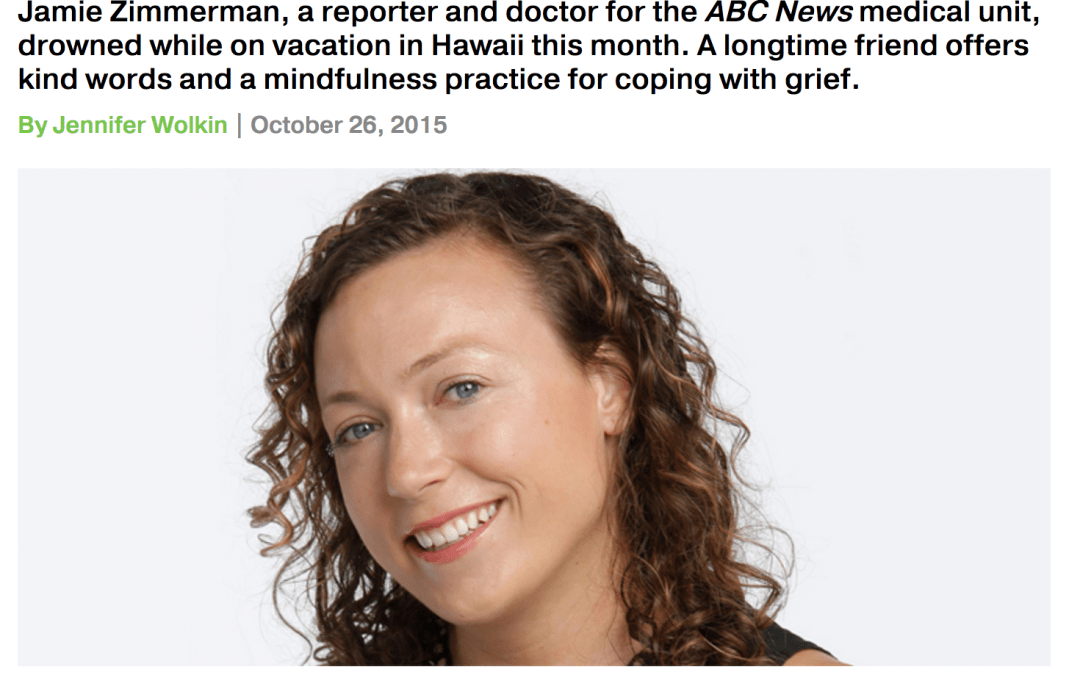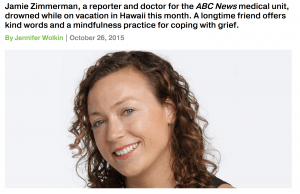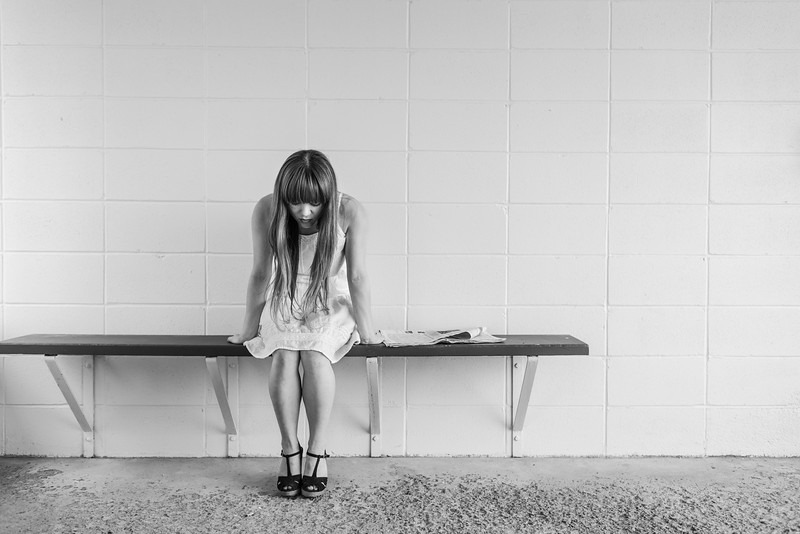
by Jennifer Wolkin | Jun 15, 2016 | Blog, PTSD, Relationships, Wellness
In honor of PTSD Awareness Month, and in response to the tragedy in Orlando, I offer five ways to help us help our children and ourselves in times of trauma.

- Give Yourself Permission to Feel Many Emotions at Different Times:
One of the core concepts of mindfulness meditation is the idea of having an attitude of non-judgment of, and openness towards, current experiences. After a tragedy, it is natural to react with shock, anger, numbness, sadness, grief, confusion, and even denial. Most often, grieving is not a linear process and you might experience yourself fluctuating between different feelings at different times, on different days and during different weeks. It is okay. Allow yourself to feel what you feel with as little judgment as possible.
- Take Care of Yourself, Then Take Care of Others:
This is true on any given day, but most importantly at a time like this. If you are anxious and your symptoms continue to persist, please reach out for support/professional guidance. More than ever, make a point to engage in your usual routine. Eat well and sleep well. Engage in healthy coping strategies (breath from your diaphragm, take a bath, journal, watch a comedy, create your own safe space and let yourself cry). Managing your own stress is a precursor to helping your children manage theirs.
- Create a Sense of Safety:
For most children, their parents symbolize safety. In times of doubt, children look to their primary attachment figures to cultivate a safe space. Let your children know you are available if they have questions and actively make yourselves available. Children don’t yet have the same cognitive tools needed to cope. Model resilience in the face of hardship without denying that hardship.
- Recognize, Be Real, But Reassure:
It is important to recognize signs of your children’s distress. Sometimes it is not obvious, as fear and anxiety might manifest as physical symptoms (stomach aches and headaches) and/or insomnia (and other sleep difficulties). Children, especially teens, might isolate and/or withdraw. Recognize the pain. Then, it is important to be real with your children. Limited media exposure is a crucial element, but on the flipside, children need to know what happened. If your children do not approach you, take the time to find out what kinds of questions they are having and what kinds of feelings they are experiencing. Use discretion (talk to them in an age-appropriate way) and be honest about what is happening; it is important not to deny the events. After honest, but age-appropriate and discrete discussion, reassure your children’s sense of safety. At this juncture, they are internalizing and probably deeply personalizing the events, wondering “when will something happen to ME.” Reassure through returning to normal routine and sending messages of safety overall. Keep life feeling as safe and predictable as possible under the circumstances.
- Reassess and Regroup:
Different people, of different ages, express trauma differently, at different times. The reaction to trauma will vary greatly. One thing, however, is for sure: The effects of trauma don’t go away easily. They might remit or decrease in severity, but they usually ebb and flow for a very long time.Healing is possible and there is hope amidst this gripping grief. As children develop they will adopt more evolved coping skills in order to adapt, and ideally the appropriate acute treatment will serve as a tool to cultivate increased resilience as time goes on. Yet, continue to reassess and regroup. It is important to continue to check in with yourself and your children if symptoms reemerge, or if other traumatic circumstances arise.
*If you need a referral to a trauma specialist, please contact me at DrWolkin@BrainCurves.com.
To Healing,
Jennifer Wolkin, PhD

by Jennifer Wolkin | Oct 26, 2015 | Relationships
This post originally appeared on Mindful.org

The other week, I lost a dear friend and colleague, Jamie Zimmerman. A physician, meditation teacher, and author, Jamie lectured internationally on “meditation medicine” and living your calling. She was passionate about global health and believed that healing happens from the inside out. A medical journalist at ABC News, she loved spending time in nature, exploring museums, yoga classes, cafes, and live music. She died as she lived—taking the time to connect to nature and herself in Hawaii, where she was taking a few days for vacation before she was going to speak at a conference.
Jamie’s death is a profound loss to so many people, and many of us grapple with understanding how to grieve. Her death was sudden and shocking, and in trying to make sense of something so seemingly senseless, I found myself remembering one of our last conversations. Jamie and I spoke about the vast potential of maintaining a beginner’s mind and that the essence of mindfulness is remembering this idea when we are faced with something we think we already know. Dear Jamie, all of us who were, and continue to be, touched by your work are forever mindful of you. As we struggle with grief, we will try to do what you would have sought to do with grace and wisdom—bring a mindful perspective to all we are now experiencing.
I offer here five ways to grieve mindfully, but first, I want to touch upon a question I’m asked often as a psychologist. What IS grief? Psychologically speaking, according to Dr. Kubler-Ross (1969), grief is an emotional response to loss. This emotional response is conceptualized as a non-linear expression of different stages of feeling states including denial, anger, bargaining, depression, and acceptance (aka: “dabda”). Biologically speaking, grief is a homeostatic process, a journey that our mind, brain, and body need to engage in to best recover from the trauma of a loss. This is an evolutionary need, since attachment and connection is embedded within our limbic circuitry. Yes, whether we are conscious of it or not, or like it or not, relationships deeply imprint upon our neuronal selves.
Grief is not, by any means, a one-size-fits-all kind of process.
Second, I want to note what grief is not. Grief is not, by any means, a one-size-fits-all kind of process. In fact, it is a uniquely individual process that often feels amorphous and difficult to capture with words. When it comes to grief, there is no “normal” or typical way to “do it.” Despite what some believe, in my opinion, there is no “normal” time period allotted for grief.
It takes a boat load of self-compassion to allow oneself to feel whatever it is you are feeling at any given time, without judgment, without comparison relative to another’s explicit portrayal of their own process. In this way, to grieve is to be mindful of our thoughts and feelings.
Finally, while there is no one “right” way to grieve, to actually grieve is essential for our ability to employ our human capacity to find a renewed sense of meaning. Grief elicits resilience. The capacity to continue to hold a loved one in our heart/mind while still forging forward with purpose and direction.
Five ways to Grieve Mindfully
- Accept your feelings: Allow yourself to feel what you feel at any given moment, with a sense of self-compassion, and without judgment.
- Express your feelings: Just as important as accepting your feelings is expressing them in a way that is helpful to you. Journaling, talking about the experience, scrapbooking, or dancing, for example, are helpful ways to process grief instead of allowing the feelings to stay stuck.
- Reach out: During this time, it is important to reach out in multiple ways. Reach out for guidance from a spiritual counselor or a psychologist. Reach out to share stories of your loved one with others. Reach out to offer support to other grievers. Find a balance between sitting with yourself, and being with others, but ultimately, reach out—don’t isolate.
- Continue to take care of yourself and others. Living life while grieving often feels like scaling a mountain. Grieving takes energy and can often feel draining. As much as possible during this tough time, continue to eat well, exercise, and maintain wellness practices.
- Celebrate your loved one’s life: It is important through the grief process to keep the memory of your loved one alive in some way that both inspires growth, and reflects and honors your unique relationship. This can include donating to a charity, meditating in their honor, and even planting a tree.

by Jennifer Wolkin | Jun 8, 2015 | Brain Health, PTSD, Wellness
PTSD and CHRONIC PAIN
PTSD is mostly known for its impact on overall mental health. There is research, however, to support the fact that PTSD is increasingly being recognized for its effect on physical wellness as well. Many who suffer with PTSD (veterans in particular) have higher lifetime prevalence of circulatory, digestive, musculoskeletal, nervous system, respiratory, and infectious disease. There is also an increased co-occurrence of chronic pain in those who suffer with PTSD.
In 1979, the International Association for the Study of Pain (IASP) officially redefined pain as, “An unpleasant sensory and emotional experience associated with actual or potential damage or described in terms of such damage”. This definition takes into account the fact that pain involves thoughts and feelings. Meaning, pain is real whether or not the biological “causes” are known, and it is ultimately a subjective experience.
Pain experienced by veterans is reported as significantly worse than the pain of the public at large because of increased exposure to injury and psychological stress during combat. Rates of chronic pain in veteran women are even higher.

All veterans with chronic pain often report that pain interferes with their ability to engage in occupational, social, and recreational activities. This leads to increased isolation, negative mood, and physical deconditioning, which all actually exacerbate the experience of pain.
Why are veterans and others who suffer with PTSD more likely to experience co-morbid chronic pain?
Well, for veterans in particular, the pain itself is a reminder of a combat-related injury, and therefore can act to actually elicit PTSD symptoms (ie, flashbacks). Additionally, psychological vulnerability such as lack of control is common to both disorders. When a person is exposed to a traumatic event, one of the primary risk factors related to developing actual PTSD is the extent to which the events and one’s reactions to them are unfolding in a very unpredictable and therefore uncontrollable way. Similarly, those with chronic pain often feel helpless in coping with the perceived unpredictability of the physical sensations.
Some say that those who experience PTSD and Chronic Pain share the common thread of “anxiety sensitivity.” Anxiety sensitivity refers to the fear of arousal-related sensations because of beliefs that these sensations have harmful consequences. A person with high anxiety sensitivity would most likely become fearful in response to physical sensations such as pain, thinking that these symptoms are signaling that something is terribly wrong. In the same vain, a person with high anxiety sensitivity will be at risk for developing PTSD because the fear of the trauma itself is amplified by a fearful response to a “normal” anxiety response to the trauma (meaning, it is very “normal” to have a strong reaction to trauma, but most sufferers actually tend to be fearful of their own response).

What has YOUR experience been? Feel free to share in this forum. We are sensitive and respectful to the emotional burden of the topic.
To Thriving,
Jennifer Wolkin, PhD

by Jennifer Wolkin | Jun 3, 2015 | Brain Health, PTSD, Relationships, Wellness
PTSD AND INTERPERSONAL RELATIONSHIPS
Trauma calls into question the basic foundation of trust in human relationships. Traumatic events not only have effects on the psychological structures of the self, but also on the attachments that link an individual to a greater community. A trauma sufferer is likely to feel as though every relationship is infused with a sense of alienation and disconnection.
The impact of trauma pulls and pulls at the threads of relationships until they tear, or in many cases, disintegrate completely. Sometimes, when I work with the significant other of a trauma sufferer, I am shocked by how far the trauma reaches. It goes inward and outward. Its tentacles have few boundaries.
It is so pervasive, that I often wonder: Is Trauma Contagious?
The literature has demonstrated that PTSD affects family cohesion, parenting satisfaction, romantic partnership, and functioning and emotional security of children. Consequently, poor functioning in these domains is associated with higher rates of divorce and higher occurrences of clinically significant levels of relationship distress in the families of veterans with PTSD than in the families of veterans without PTSD or in the general population.
It probably can’t be overemphasized that poor health outcomes for children (poor development, higher rates of illness, lower academic performance, and cardiovascular disruption) are closely linked to this now-stressful family environment, which is created when the symptoms of PTSD literally intrude upon the family or relationship structure.
PTSD symptoms affect personal relationships indirectly as well. For example, veterans with PTSD are more likely than members of the general population to have clinically significant levels of depression, anxiety, anger, and violence. They are more likely to abuse substances and less likely to hold steady employment. All of these play a role in the breakdown of interpersonal functioning.
The nature of interpersonal problems experienced by combat exposed veterans appears to be correlated with the presence in particular of the avoidance and numbing characteristics of PTSD. In families and relationships, avoidance and numbing may create social isolation, a cold, and unresponsive parenting style, anger, and an absence of emotional warmth.
One of the most consistent relationships observed in trauma research is the inverse relationship between PTSD symptoms and social support (that is, the more social support, the fewer symptoms). The ultimate sad irony is that the people in the world of the trauma survivor are pushed away, though connection is the very thing that is needed.
A supportive response has shown to mitigate the impact of trauma, as the survivor yearns to establish a basic sense of safety and trust. The trauma survivor needs the help of others to rebuild his or her shattered sense of self. Yet, it is a long arduous process during which the survivor cycles between the need for extreme closeness and the need for distance and time to reestablish self-autonomy.
During this process, the toll that these cycles take is hard to gauge. In some cases, members of the support system suffer their own kind of trauma. If merely witnessing the person you love suffering through trauma is not a sort of trauma unto itself, then I don’t know what is.
Recovery for the sufferers and support systems is possible. It is crucial that health professionals understand the impact of PTSD on interpersonal functioning in order to provide the best treatment approaches for the sufferers and their social systems.

This is the third in a series of BrainCurves posts that I will be sharing on the topic of Trauma and PTSD throughout the month of June, National PTSD Awareness Month. Next week I will post about PTSD and Chronic Pain.
To Thriving,
Jennifer Wolkin, PhD

by Jennifer Wolkin | Jun 1, 2015 | Brain Health, PTSD, Wellness
PTSD AND GENDER
Both women and men are at risk of enduring unfathomable trauma, but it’s important to emphasize gender differences here, with the hopes that they can ultimately be a much-needed catalyst for improved preventative measures, diagnosis, and treatment.
In 2006, Tolin and Foa reviewed the results of about 25 studies, and indicated that women are approximately 2x as likely to meet criteria for PTSD than men, and also approximately 4x as likely to have more chronic iterations of PTSD.
The question that is begged is, what might account for the higher rates of diagnosis in women?
- Women are NO more likely to experience trauma in general, but ARE more likely to experience certain types of trauma, including sexual abuse and assault. These types of trauma are associated with greater risk for PTSD.
- When compared with male trauma survivors, women tend to react with self-blame, belief that their incompetence lead to trauma, and coping skills that are maladaptive such as mental disengagement and suppression of traumatic memories. This seemingly gender-specific expression of emotional distress post-trauma might explain greater rates of PTSD in women.
- Increased baselines of anxiety and depression might put women at greater risk for developing PTSD. Most studies assess participants after trauma has occurred, without taking into account base rates of premorbid psychological distress. This limitation can inflate the risk of PTSD.
- Women are more likely than men to experience multiple traumas across their lifespan and the cumulative effects of repeated traumas likely increase their risk of developing PTSD.
Research directed toward specific details regarding gender differences and veterans is still scarce. It is incumbent upon any clinician, who is screening for PTSD and related difficulties, to be sensitive to this difference.
Female Veterans and PTSD
Women veterans are particularly at risk of being involved in different types of traumatic incidences. There are reports of being sexually (rape) and physically assaulted during military duty, as well as experiencing “duty-related” trauma as part of their military exposure (i.e., warzone exposure).
Also, it is not uncommon to hear that many women in the military have suffered preliminary trauma that might predispose them to the development of full-blown PTSD following a subsequent traumatic exposure.
Recently, research indicated that screening positive for PTSD is associated with a range of self-reported health problems and functional impairments specifically among female VA patients. These include fibromyalgia, stroke, irritable bowel syndrome, chronic pelvic pain, and obesity. In some studies, women reported poor health-related quality of life (HRQoL) relative to both male veterans and non-veteran women. Veteran women with PTSD have significantly more somatic distress, co-morbid medical conditions, psychiatric difficulty, and substance abuse rates than non-veteran women.
Female Veterans and PTSD + Chronic Pain
Women veterans specifically diagnosed with PTSD usually have significantly higher rates of pain and overall poorer health than women in the general population. There is not a lot known about the context of “military culture” that might have implications for women’s health behaviors. Yet, veteran women’s increased prevalence of chronic pain is probably because their pain is compounded upon by extreme conditions that are not experienced by civilian women. The ability to manage chronic pain is probably egregiously limited within military context, such that pain is probably maintained or progressively worsens with little relief.
When chronic pain cannot be readily explained as the direct consequence of tissue damage, some people treating veteran women are apt to think, “It is all in the head.” Although at greater risk for experiencing PTSD and co-morbid pain, women veterans are usually under-diagnosed and also under-use mental health services. A reason cited is that even in our progressed society, women in this position continue to be stigmatized.

I want to take a moment to mention the obvious: both PTSD and Chronic Pain sufferers are often stigmatized. They are relegated to the “outskirts” of the community, and become “liminal” creatures. I see time and again that those who experience either trauma and/or pain are perceived as victims of their own devices rather than just as sufferers.
Fibromyalgia is a common diagnosis given to women post-deployment. As such, women are stereotyped as somatisizers and told that their pain is elicited from the mental construct called the psyche, and not the brain. This concept of somatization implies that pain symptoms are exaggerated or feigned and ultimately within the control of the sufferer.
A variety of social and medical critics view chronic pain in women as a post-modern illness sharing a lineage with nineteenth-century pseudo-maladies like hysteria. These illnesses, they contend, originate in vulnerable human psyches. Central to these suspicions is the seemingly unshakable belief that chronic pain is a psychosomatic disorder, with the implication that the sufferer’s pain is not medically “real.” Within this conceptual framework is the archetype of the traumatized woman who experiences her trauma symptoms in her body. I urge women to take a stand against stereotyping and to pursue quality treatment despite critics who might make it seem unwarranted.
As always…this is a stigma-free, nonjudgmental, open community. Your comments regarding intellectual, theoretical, and, of course personal accounts of trauma are cared for here. We’d love to hear from you.
To Thriving,
Jennifer Wolkin, PhD








